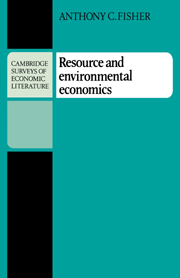Book contents
- Frontmatter
- Contents
- List of tables and figures
- Preface
- 1 Introduction
- 2 Exhaustible resources: the theory of optimal depletion
- 3 Renewable resources: the theory of optimal use
- 4 Resource scarcity: are resources limits to growth?
- 5 Natural resources and natural environments
- 6 Environmental pollution
- 7 Some concluding thoughts: the role of economics in the study of resource and environmental problems
- References
- Author index
- Subject index
3 - Renewable resources: the theory of optimal use
Published online by Cambridge University Press: 07 October 2009
- Frontmatter
- Contents
- List of tables and figures
- Preface
- 1 Introduction
- 2 Exhaustible resources: the theory of optimal depletion
- 3 Renewable resources: the theory of optimal use
- 4 Resource scarcity: are resources limits to growth?
- 5 Natural resources and natural environments
- 6 Environmental pollution
- 7 Some concluding thoughts: the role of economics in the study of resource and environmental problems
- References
- Author index
- Subject index
Summary
Introduction
The line between exhaustible resources and renewable resources is not always clearly drawn. Exploration and technical change can, for a time at least, “renew” exhaustible resources by making possible production from new deposits and low-grade materials. Models that describe the effects of these activities on resource price and production paths were developed in Chapter 2.
Just as exhaustible resources can be renewed, renewable resources can be exhausted. In fact, as we noted in the concluding remarks to Chapter 2, much of the concern about resource exhaustion appears to involve renewable resources, endangered species ranging from the snail darter to the whale. As one prominent biological scientist put it:
The worst thing that can happen—will happen [in the 1980s]—is not energy depletion, economic collapse, limited nuclear war, or conquest by a totalitarian government. As terrible as these catastrophes would be for us, they can be repaired within a few generations. The one process ongoing in the 1980s that will take millions of years to correct is the loss of genetic and species diversity by the destruction of natural habitats. This is the folly our descendants are least likely to forgive us.
A major purpose of this chapter is to try to shed some light on the reasons that even commercially valuable stocks of plants and animals can be threatened with extinction. It is clear enough how this can happen to a species that is not commercial.
- Type
- Chapter
- Information
- Resource and Environmental Economics , pp. 75 - 89Publisher: Cambridge University PressPrint publication year: 1981



